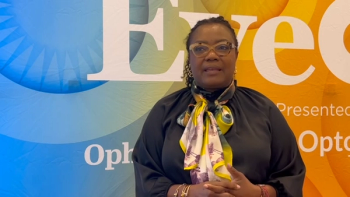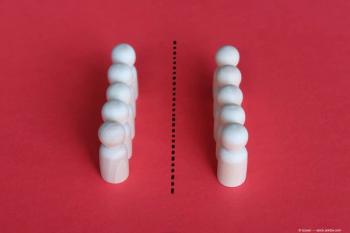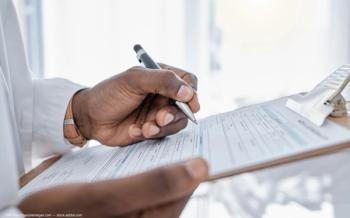
Retina Society 2024: Observational, retrospective US-based cohort study on newly diagnosed geographic atrophy
Theodore Leng, MD, MS, sat down with David Hutton of Ophthalmology Times to discuss his presentation on Progression of Newly Diagnosed Geographic Atrophy: An Observational, Retrospective US-based Cohort Study at the annual Retina Society meeting being held this year in Lisbon, Portugal
Theodore Leng, MD, MS, sat down with David Hutton of Ophthalmology Times to discuss his presentation on Progression of Newly Diagnosed Geographic Atrophy: An Observational, Retrospective US-based Cohort Study at the annual Retina Society meeting being held this year in Lisbon, Portugal
Video Transcript:
Editor's note: The below transcript has been lightly edited for clarity.
David Hutton:
I'm David Hutton of Ophthalmology Times. The Retina Society is holding its annual meeting in Lisbon, Portugal. At that meeting, Dr Ted Leng is presenting "Progression of Newly Diagnosed Geographic Atrophy: An Observational, Retrospective US-based Cohort Study." Dr Leng, thank you so much for joining us. First, what key factors did your study identify as predictors of progression in patients with newly diagnosed geographic atrophy?
Theodore Leng, MD, MS:
Thanks for having me, David. I thought this study was really exciting because we were able to look at a large retrospective, real-world data set of de-identified EHR records from a geographic diverse panel of US based private retina specialists. Just to give a short recap, we looked at patients 50 years or older with GA in at least 1 eye between October 2015 and April 2023. The initial cohort was about 2 million patients, of which we had a final study population, of about 60,500 eyes, a little more than those had unilateral disease, and we had follow up data for up to 5 years. What we did find was that progression in lesion location was very common. So progression meaning going from extra-foveal to sub-foveal for GA. And this was especially common in patients who had GA in the fellow eye. So that was one major finding. We also found that eyes with GA experience a meaningful loss of visual acuity even in the first few years of the study. And then change in lesion location is a potential factor for predicting disease progression and outcomes.
David Hutton:
Were there any specific baseline characteristics, such as, say, age, comorbidities or lifestyle factors that seem to influence the rate of atrophy progression in the cohort?
Theodore Leng, MD, MS:
We didn't see anything as far as baseline factors that were predictive or were associated with more progression. We did see more female patients, as can be expected, in this population. And most of the patients actually had at least one other ocular comorbidity, were pseudophakic and had sub-foveal lesions at baseline. And the baseline characteristics were generally similar between the unilateral and the bilateral eyes with GA, although ocular comorbidities were more frequent in the fellow eye of patients with the unilateral GA.
David Hutton:
How might the findings of this study impact clinical management strategies for patients diagnosed with GA, particularly regarding monitoring and treatment options.
Theodore Leng, MD, MS:
I think the thing that was most concerning to me, which we've seen in other real-world studies, as well is that eyes with GA lose up to a mean of 12 letters of vision within 5 years. Those eyes that developed neovascular AMD had the largest loss in visual acuity, losing up to 15 letters between the initial index of geographic atrophy diagnosis and then year five. So to me, I think this study gives us 2 things to consider. One is that patients with GA or new onset GA will lose vision in the first few years. So looking at therapies that have the potential to prevent or slow down vision loss, I think it's really important to really consider those therapies. Of course, we've got 2 that are FDA approved on the market here in the US, for us to consider the anti complement therapies. And the second thing is to really be cognizant and screen for the new onset of neovascular AMD in these eyes, and really be proactive at treating that, both detecting it and initiating therapy with anti VEGF to really limit the loss of vision in those eyes that do convert to neovascular AMD.
David Hutton:
Ultimately, What can this mean for retina specialists and the GA patients they are treating?
Theodore Leng, MD, MS:
Well, I think, you know, we need to really focus on treating GA. I think, you know, we're traditionally taught, and we've always assumed that dry AMD was a very slowly progressive disease, and maybe it didn't really cause a large impact to our patient's visual function and lives. But I think the opposite is actually the truth now that these real world studies have come to light–is that patients do have significant and meaningful vision loss, even in the first few years with the diagnosis of GA. We certainly want to address that, you know, to preserve vision, prevent progression to sub-foveal location, and also prevent and treat progression to neovascular disease.
David Hutton:
And finally, what's the next step for this research?
Theodore Leng, MD, MS:
Well, I think you know, we need to continue following these patients, looking at these real world data sets, and also now that we have these two agents out in the real world, looking at the outcomes. Whether there is a bending of the curve or a change in the direction of these eyes once they initiate therapy. So comparing these natural history studies to what's happening in the real world with the use of these new anti complement agents.
Newsletter
Don’t miss out—get Ophthalmology Times updates on the latest clinical advancements and expert interviews, straight to your inbox.


















































.png)


